Geochemical Measurements of Carbonate Sediment Production and Organic Productivity in Florida Bay:
A Potential Measure of Restoration Progress
Kimberly Yates and Robert Halley, U.S. Geological Survey, St. Petersburg, Florida
http://sofia.usgs.gov and http://coastal.er.usgs.gov
Introduction
We have developed and tested techniques for in situ measurement of biogeochemical processes associated with benthic habitats. Productivity in Florida Bay basins was determined using a large, submersible incubation chamber (S.H.A.R.Q.) to measure temporal geochemical changes associated with benthic productivity (Figure 1). Productivity on banks was determined by measuring spatial geochemical changes across banks using an upstream/downstream sampling approach (Figure 8). Successful field trials indicate that geochemical productivity measurements are an effective measure of these biogeochemical processes and will serve as a valuable ecological performance measure for restoration progress.
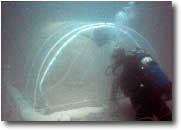

Figure 3. Water is pumped from S.H.A.R.Q. through a flow-through analytical system on the surface for geochemical analyses.
S.H.A.R.Q.
Carbonate sedimentation and organic productivity (calcification, photosynthesis and respiration) are most effectively determined from precise, in situ measurements of alkalinity, pH, temperature, conductivity, and air:sea CO2 and O2 gas fluxes (Smith and Key, 1975; Millero, 1979; Barnes, 1983; Gattuso et al., 1993; Millero et al., 1993). Temporal geochemical changes were measured by deploying a large incubation chamber called the Submersible Habitat for Analyzing Reef Quality (S.H.A.R.Q.) in seagrass beds located in basins near Buchanon and Russell Banks. The S.H.A.R.Q. consists of a 16(l) x 8(w) x 4(h) ft. PVC frame covered with clear vinyl sheeting. A circulation system generates a current inside of the tent and carries water to the surface through a flow-through analytical system for geochemical analyses and water sampling. (Figures 1-3).
We have successfully tested the S.H.A.R.Q. in both deep (>40 ft.) and shallow (<4 ft,) water in South Florida coastal waters including Florida Bay. Fluorescein dye was injected into the tent during dark hours to test for leaks. Results corrected for absorption to sediments and photochemical decay (Smart and Laidlaw, 1977) showed no decrease in dye concentrations indicating no leakage of water during incubation periods (Figure 4).
Buchanon Bank Basin

Sontek current meters were used to assess circulation characteristics inside of the S.H.A.R.Q. Initial results indicate that flow is not laminar, and suggest that turbulent flow may occur within the tent. Additional measurements will be required to accurately characterize flow patterns.
The effects of clear vinyl sheeting on photosynthetically active radiation (PAR) were examined by measuring PAR attenuation with water depth using a LiCor quantum sensor covered with a clear vinyl sleeve. No difference in PAR attenuation occurs between sleeved and unsleeved sensor data below a depth of 3 feet. Clear vinyl sheeting reduces PAR by 29% at 1 foot, 21% at 2 feet, and 4% at 3 feet water depth relative to measurements taken using an unsleeved sensor (Figure 5).
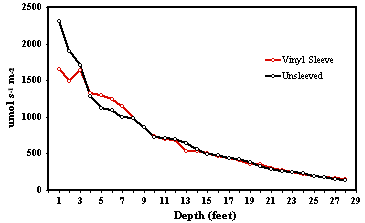
Basin Productivity
Calcification, photosynthesis, and respiration were measured during winter (March) and Summer (September) on seagrass beds located in basins near Buchanon Bank and Russell Bank using the S.H.A.R.Q. Geochemical parameters including pH, dissolved oxygen, fluorescence, and temperature were measured continuously through the S.H.A.R.Q.'s flow-through analytical sytem (Figures 6 and 7) throughout the duration of incubation periods (from 20-28 hours). Water samples were removed from sample ports every 4 hours for alkalinity measurements via the Gran titration method using methods of Millero (1979). Dissolved oxygen, pH and alkalinity data were used to calculate rates of net calcification, photosynthesis, and respiration for each 4 hour interval between alkalinity measurements during incubation periods. Productivity parameters were calculated using the alkalinity anomaly technique (Smith and Key, 1975) and carbonate system equations of Millero (1979), whereby ![]() concentration of each parameter/
concentration of each parameter/![]() T x S.H.A.R.Q. volume/S.H.A.R.Q. surface area = g C m-2s-1. Sample interval rates were then used to calculate net daily production rates which were then used to derive average hourly rates of calcification, photosynthesis, and respiration (Figure 12a and b).
T x S.H.A.R.Q. volume/S.H.A.R.Q. surface area = g C m-2s-1. Sample interval rates were then used to calculate net daily production rates which were then used to derive average hourly rates of calcification, photosynthesis, and respiration (Figure 12a and b).
Buchanon Bank Basin, Winter

Buchanon Bank Basin, Winter

Buchanon Bank Basin, Summer
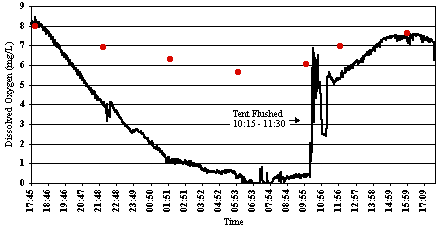
Buchanon Bank Basin, Summer

Russell Bank Basin, Winter

Russell Bank Basin, Winter

Russell Bank, Summer

Russell Bank Basin, Summer
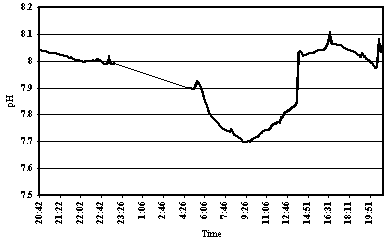
Bank Productivity
Calcification, photosynthesis, and respiration were measured during winter (March) and Summer (September) on Russell Bank using an upstream/downstream sampling strategy. Spatial geochemical parameters were determined by establishing upstream and downstream sampling sites along 200-400m transects across Russell Bank
(Figure 8). Current directions and velocities were determined by deploying Sontek current meters on the bank (Figure 9a). Calcification, photosynthesis, and respiration were calculated from total alkalinity, pH, dissolved oxygen, air:sea CO2 and O2 gas fluxes, salinity, temperature, and wind measurements (Figure 9b and c). Water samples were collected and analyzed for total alkalinity at upstream and downstream sites approximately every 4 hours throughout 24 hour time intervals. Total alkalinity was used to calculate net calcification using the alkalinity anomaly technique of Smith and Key (1975). Total carbon was calculated using carbonate system equations from Millero (1979). Air-sea CO2 fluxes were measured directly at each station inside of a floating bell (Sugiura et al., 1963; Frankignoulle and Distéche, 1984; Frankignoulle, 1988; Gattuso et al., 1993; Kayanne et al., 1995) using the procedure and calculations of Frankignoulle (1988) (Figures 10 and 11). Air-sea O2 fluxes were determined by measuring atmospheric and water pO2 and calculating fluxes as described in Wanninkhof (1992). Differences in oxygen and carbon metabolism between upstream and downstream stations were corrected for O2 and CO2 exchange with the atmosphere as described in (Gattuso et al., 1993). Productivity and metabolic rates per unit area were calculated using the difference in concentration between upstream and downstream stations, the volume of water transported along a transect, and the transect area such that the change in concentration of a parameter (
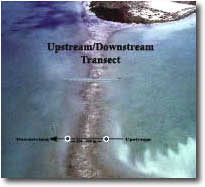

Figure 8. Example of upstream/downstream sampling strategy across a typical mud bank in Florida Bay. (a.) Sontek current meters are deployed on the bank top near its edge. Current speed and direction are recorded at 1 second intervals throughout the duration of monitoring (typically 24 hours). Upstream and downstream sample stations are located at each end of a transect perpendicular to the bank (white rings (a.) and circles (b.)). Geochemical and physical parameters including dissolved oxygen, pH, alkalinity, air:sea CO2 and O2 gas fluxes, temperature, salinity, and wind speed are measured at each station every 4 hours. Transects are typically 200-400 meters in length. (Click on images above for larger versions.)
![]() C m-2s-1) = (C m-3 x m3hr-1)/m2 (Barnes and Devereux, 1984). Productivity data from 4 hour sample intervals was used to calculate net daily production rates for mud banks. Net daily production rates were used to derive average hourly rates of calcification, photosynthesis and respiration (Figure 12c and d).
C m-2s-1) = (C m-3 x m3hr-1)/m2 (Barnes and Devereux, 1984). Productivity data from 4 hour sample intervals was used to calculate net daily production rates for mud banks. Net daily production rates were used to derive average hourly rates of calcification, photosynthesis and respiration (Figure 12c and d).
B. Russell Bank Upstream/Downstream Transect Data, Winter 1999
C. Russell Bank Upstream/Downstream Transect Data, Summer 1999
Russell Bank
Transect Location
(meq/kg)
mg/L
mols m-2s-1
Upstream
Downstream
16:32
8.085
2.7710
8.06
3.73E-05
Upstream
Downstream
21:11
8.042
2.7639
7.10
5.93E-05
Upstream
Downstream
0:12
8.031
2.7780
6.66
3.02E-05
Upstream
Downstream
4:20
8.061
2.7576
6.75
3.19E-05
Upstream
Downstream
8:20
8.064
2.7589
7.26
7.33E-06
Upstream
Downstream
12:06
8.160
2.7285
9.30
-8.43E-05
Upstream
Downstream
16:15
8.114
2.7260
8.41
-4.75E-05
Transect Location
(meq/kg)
mg/L
mols m-2s-1
Upstream
Downstream
12:25
8.207
2.4411
6.32
1.58E-04
Upstream
Downstream
15:55
8.160
2.4176
6.68
1.75E-04
Upstream
Downstream
20:40
8.145
2.4069
6.25
3.52E-05
Upstream
Downstream
0:00
8.127
2.4171
5.69
7.99E-05
Upstream
Downstream
4:00
8.107
2.4200
4.79
1.04E-04
Upstream
Downstream
8:00
8.086
2.4027
4.33
1.79E-04
Upstream
Downstream
12:30
8.144
2.4045
5.83
1.75E-04
Upstream
Downstream
16:07
8.174
2.4151
7.10
9.25E-05
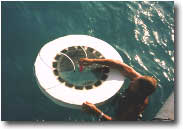

Basin Productivity
A. Average Rates Calcification, Photosynthesis, Respiration
Basins
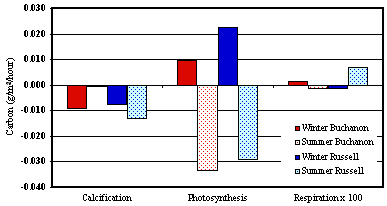
B. Basin Carbonate Sediment Production

|
Basins  |
 |
Respiration - Russell Bank
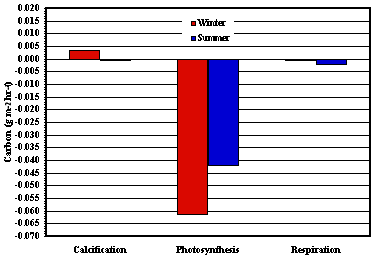
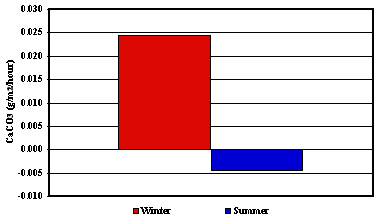
Monitoring Restoration Progress
Successful field trials indicate that the S.H.A.R.Q. and upstream/downstream sampling strategies are effective methods for measuring calcification, photosynthesis, and respiration (productivity). Biogeochemical processes such as these are sensitive to water quality and respond to water quality changes before visual evidence of ecosystem perturbations (such as changes in species distributions) becomes apparent. Monitoring these biogeochemical processes as water quality changes during restoration efforts can be used as an effective ecological performance measure for restoration progress, may provide an early response system for identifying ecological perturbations, and will provide insight into the link between biological function and environmental quality.
Additionally, the S.H.A.R.Q. provides a mechanism for in situ alteration of environmental parameters such as salinity, pCO2, turbidity, and nutrients. This will enable investigations on the response of benthic communities to environmental stress. Experiments such as these will provide the information necessary for predicting the response of coastal ecosystems to climate change and declining water quality resulting from natural and anthropogenic influences.
Related information:
![]() Click here for a printable version of this poster (note: document will
open in a new browser window)
Click here for a printable version of this poster (note: document will
open in a new browser window)
SOFIA Project: Geochemical Monitoring of Restoration Progress
This page is: http://snowball /publications/posters/geochem_measure/index.html
Comments and suggestions? Contact: Heather Henkel - Webmaster
Last updated: 11 October, 2002 @ 09:35 PM (KP)


